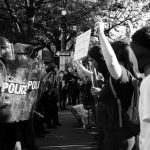The history of the prison industrial complex is a long winding tale of oppression and terror that people of color have been trying to tell us about for far too long. This section is part two of a 6 part series on the long road we have taken to get to this place. In case you missed it, click here to visit part 1.
Many things happened outside of our control. However, just because we aren’t directly to blame that doesn’t mean we don’t have a responsibility to help make this world fair and equal for everyone who inhabits it.
We can’t continue to pretend like there is nothing we can do.
THE 13Th
The 13th is a Documentary by Ava Duverney. The film is named such after the Thirteenth Amendment which was the one that abolished slavery. If you haven’t seen this startling documentary, do so at your soonest available opportunity. You can stream it using Netflix. It is an eye-opening look at exactly how the United States has kept people of color as slaves in one form or another since they were ‘set free’ in the 1800s.
The Thirteenth Amendment states:
“Neither slavery nor involuntary servitude, except as a punishment for crime whereof the party shall have been duly convicted, shall exist within the United States, or any place subject to their jurisdiction.”
Here’s the rub, and the 14 short words that started the whole thing:
“…Except as punishment for a crime whereof the party shall have been duly convicted.”
Those words inadvertently set up a system that is rotten to the core and directly resulted in the injustice, systemic racism, and racial disparity that we see today.
Kevin Gannon in the 13th said:
“But if you dismiss black complaints of mistreatment by police as being completely rooted in our modern context, then you’re missing the point completely. There has never been a period in our history where the law and order branch of the state has not operated against the freedoms, the liberties, the options, the choices that have been available to the black community, generally speaking. And to ignore that racial heritage, to ignore that historical context, means that you can’t have an informed debate about the current state of blacks and police relationship today, ’cause this didn’t just appear out of nothing. This is the product of a centuries-long historical process. And to not reckon with that is to shut off solutions.”
Ms. Duvernay told Oprah in an interview about the film that it was first going to be about the prison industrial complex in its modern form. However, once she started digging into the information, she realized she couldn’t tell the story without REALLY telling the story. I agree with her wholeheartedly.
As you will see, starting immediately after they were “freed,” the United States designed systems specifically to keep people of color oppressed.
FOLLOWING THE CIVIL WAR
After the Civil War ended, the slaves were “free,” from one life of servitude, at least. The South was decimated by the war; however, and desperately needed to rebuild. They needed cheap labor – and fast.
Someone had the brilliant idea of using prisoners to rebuild both the prisons to house them and other structures. The companies paid the prisons to allow them the use of the prisoners incarcerated there for the back-breaking labor. They rarely paid the “laborers,” and when they did, it was a pittance.
They started arresting freed slaves en masse for things like loitering and vagrancy. Conversely, let’s not pretend they even needed a reason to arrest them. It stands true to this day that if you are a person of color, you don’t need actually to break the law to get thrown in jail. Let’s stop pretending otherwise.
Sadly, the prisons treated convicts even more abhorrently than slave owners treated slaves. You see, the slaves were monetarily valuable to their owners, who spent money to purchase them. The jails didn’t care one whit if a prisoner was killed or injured, as there were plenty of those to be had for free.
NEXT CAME JIM CROW
Segregation came next in the form of “Jim Crowe laws,” which were a codified system of American apartheid that took the form of terrorism on the Black community.
In the South, people of color faced terrors you and I cannot fathom. They were beaten for no reason, treated as second-class citizens, and not allowed to attend the same schools. They couldn’t use the same bathrooms, sit in the same area of the bus, or use the same beaches as white people.
They killed four little girls in a church bombing in Alabama, they watched their mothers and fathers jailed for no reason, and they had men wearing white hoods to mask their identities hanging them from trees and burning crosses on their lawns. Some were able to move away from the worst of it. Others were not so lucky.
Systems of oppression are durable and they tend to reinvent themselves. – Glenn Martin, 13th
Riots broke out across the country, much like we see today. It was a dark time in this country before influential leaders from the Black community rose up and started demanding equal rights. Malcolm X, Martin Luther King Jr., and Angela Davis emerged as leaders in the movement.
Eventually, the United States made segregation illegal, but not before decimating the Black community of their leaders. Nearly to a man the leadership ended up in jail, exiled to other countries, or dead.
THE STATE AND BLACK LEADERS
This country has never treated black leaders with anything approaching fairness. Think for a moment about how they react to Barack Obama today. Now, translate that to the time when people of color were still fighting segregation.
Of course, today we learn that Martin Luther King Jr. was the hero of the movement. There is a Martin Luther King Jr. Boulevard in nearly every city across the nation. He is celebrated for his achievements in helping the Black community advance and achieve a semblance of equality.
That was not always the case, however.
During the 1950’s and 60’s, Dr. King was on the FBI’s top 10 most wanted list. Right alongside every other civil rights leader from that time. They were either wanted by law enforcement or taken out with a bullet to the head.
Van Jones, a correspondent for CNN, said:
“You can tell the story of white leadership in America and never mention the FBI one time. You can’t tell the story of black leadership, not one, without having to deal with the full weight of the criminal justice system weaponizing its black dissent.”
All this, and we haven’t even started talking about mass incarceration yet. Of course, following the Civil War many freed slaves were arrested on those trumped up charges, if any at all, but that was nothing compared to what they cooked up in the 1970s and 80s for people with brown skin.
Stay tuned for the Part 3 of this comprehensive 6 part series detailing systemic racism in the U.S. that explains how we got here and how we can find our way back.
Featured Image Via YouTube Video.











